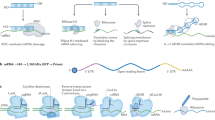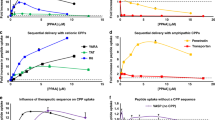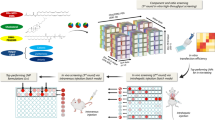Abstract
Delivery of plasmid DNA for gene therapy often provokes an inflammatory response that reduces transgene expression. Cationic lipids for lipofection lack pharmacological activity despite the hydrophobicity of many drug candidates that could be exploited. We report a one-step synthesis of a water-soluble, dexamethasone–spermine (DS) cationic lipid that has potent gene transfer capability in confluent endothelial cells when used with the neutral lipid, dioleoylphosphatidylethanolamine (DOPE). In contrast, unconjugated mixtures of dexamethasone, spermine, and/or DOPE have essentially no gene transfer activity. DS retains partial corticosteroid character as quantified by the rapid translocation of glucocorticoid receptor to the nucleus and by dose-dependent transactivation from a glucocorticoid response element. DS has anti-inflammatory activity in vivo in the mouse thioglycollate model of inflammation. In a mouse lung model, DS:DOPE resulted in significantly less interferon-γ production at Day 1 and elevated transgene expression at Days 1 and 7 postintranasal instillation compared to DC-Chol:DOPE (sterol:DOPE:phosphate molar ratio of 1:1:1). Cationic pharmacophores such as DS represent a new approach to gene delivery and localized therapy.
This is a preview of subscription content, access via your institution
Access options
Subscribe to this journal
Receive 12 print issues and online access
$259.00 per year
only $21.58 per issue
Buy this article
- Purchase on Springer Link
- Instant access to full article PDF
Prices may be subject to local taxes which are calculated during checkout





Similar content being viewed by others
References
Tan Y et al. The inhibitory role of CpG immunostimulatory motifs in cationic lipid vector-mediated transgene expression in vivo. Hum Gene Ther 1999; 10: 2153–2161.
Tousignant JD et al. Comprehensive analysis of the acute toxicities induced by systemic administration of cationic lipid:plasmid DNA complexes in mice. Hum Gene Ther 2000; 11: 2493–2513.
Scheule RK et al. Basis of pulmonary toxicity associated with cationic lipid-mediated gene transfer to the mammalian lung. Hum Gene Ther 1997; 8: 689–707.
Li S et al. Effect of immune response on gene transfer to the lung via systemic administration of cationic lipidic vectors. Am J Physiol 1999; 276: L796–804.
Wiseman JW, Goddard CA, Colledge WH . Steroid hormone enhancement of gene delivery to a human airway epithelial cell line in vitro and mouse airways in vivo. Gene Therapy 2001; 8: 1562–1571.
Braun S et al. In vitro and in vivo effects of glucocorticoids on gene transfer to skeletal muscle. FEBS Lett 1999; 454: 277–282.
Lasic D . Liposomes in Gene Delivery. CRC Press: Boca Raton, FL, 1997.
Schimmer BP, Parker KL In: Hardman JG, Limbird LE (ed) The Pharmacological Basis of Therapeutics. McGraw-Hill: New York, 1996, pp 1459–1485.
Hermanson G . Bioconjugate Techniques. Academic Press: London, 1996.
Simmons SJ, Pons M, Johnson DF . Alpha-keto mesylate: a reactive, thiol-specific functional group. J Org Chem 1980; 45: 3084–3088.
Geall AJ et al. Synthesis of cholesteryl polyamine carbamates: pK(a) studies and condensation of calf thymus DNA. Bioconjug Chem 2000; 11: 314–326.
Subramanian A, Ranganathan P, Diamond SL . Nuclear targeting peptide scaffolds for lipofection of nondividing mammalian cells. Nat Biotechnol 1999; 17: 873–877.
Ashwell JD, Lu FW, Vacchio MS . Glucocorticoids in T cell development and function. Ann Rev Immunol 2000; 18: 209–345.
Chidambaram N, Zhou L, Cohen JS . Targeting of antisense: synthesis of steroid-linked and steroid-bridged oligodeoxyribonucleotides. Drug Deliv 1996; 3: 27–33.
Acedo M et al. Preparation of oligonucleotide–dexamethasone conjugates. Bioorg Med Chem Lett 1995; 5: 1577–1580.
Rebuffat A et al. Selective enhancement of gene transfer by steroid-mediated gene delivery. Nat Biotechnol 2001; 19: 1155–1161.
Lee ER et al. Detailed analysis of structures and formulations of cationic lipids for efficient gene transfer to the lung. Hum Gene Ther 1996; 7: 1701–1717.
Walker D, Htun H, Hager GL . Using inducible vectors to study intracellular trafficking of GFP-tagged steroid/nuclear receptors in living cells. Methods 1999; 19: 386–393.
Acknowledgements
This work was supported by National Institutes of Health Grant 66565 and Cystic Fibrosis Foundation Grants D01IO and 5886. JG is an NSF Graduate Research Fellow and SLD is an established investigator of the American Heart Association. We graciously thank Dr Gordon Hager (Laboratory of Receptor Biology and Gene Expression, NIH) for the 3T3 cell line 3676, and Dr Haiching Ma for helpful discussions. We thank Dr Daniel Weiner (Division of Medical Genetics, U Penn.) for his help with the mouse studies.
Author information
Authors and Affiliations
Rights and permissions
About this article
Cite this article
Gruneich, J., Price, A., Zhu, J. et al. Cationic corticosteroid for nonviral gene delivery. Gene Ther 11, 668–674 (2004). https://doi.org/10.1038/sj.gt.3302214
Published:
Issue Date:
DOI: https://doi.org/10.1038/sj.gt.3302214
Keywords
This article is cited by
-
Glucocorticoid Cell Priming Enhances Transfection Outcomes in Adult Human Mesenchymal Stem Cells
Molecular Therapy (2016)
-
Ternary Complexes with Core-Shell Bilayer for Double Level Targeted Gene Delivery: In Vitro and In Vivo Evaluation
Pharmaceutical Research (2013)
-
TLR9 and IRF3 Cooperate to Induce a Systemic Inflammatory Response in Mice Injected With Liposome:DNA
Molecular Therapy (2010)
-
Cationic Lipid Formulations Alter the In Vivo Tropism of AAV2/9 Vector in Lung
Molecular Therapy (2009)
-
Pulmonary delivery of adenovirus vector formulated with dexamethasone–spermine facilitates homologous vector re-administration
Gene Therapy (2007)



